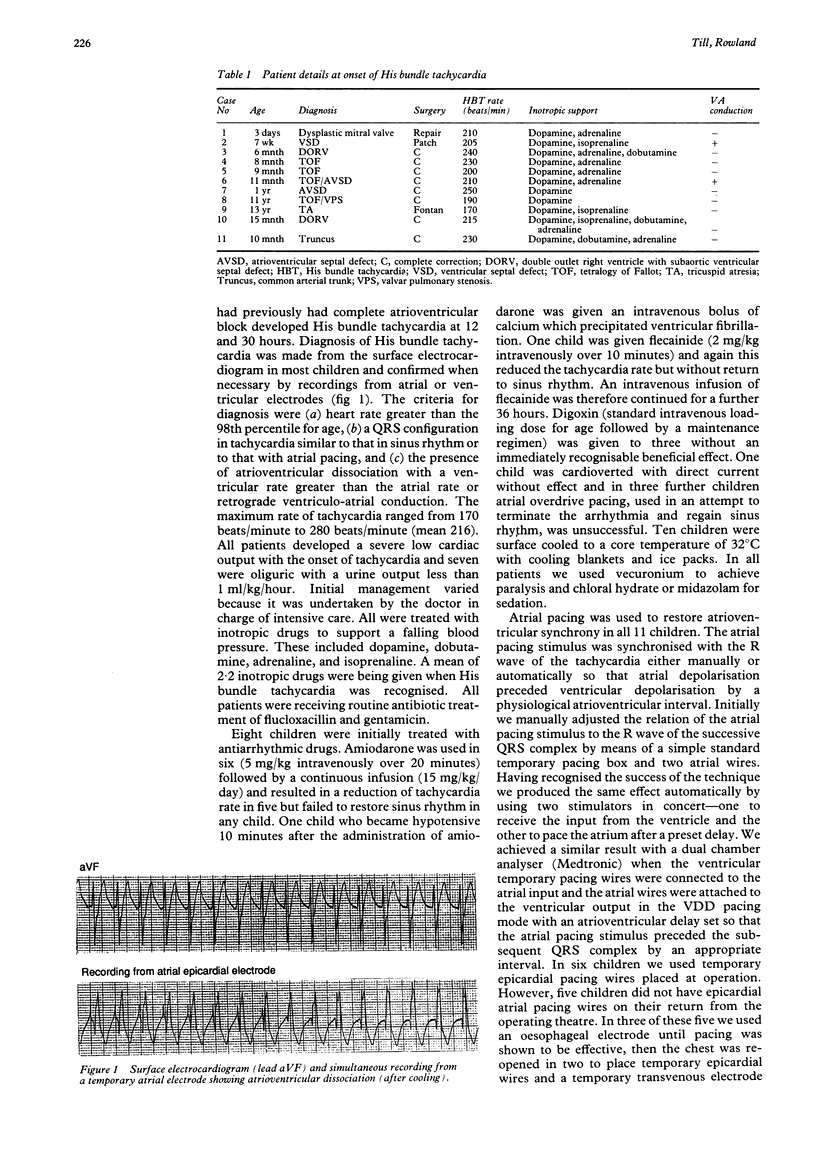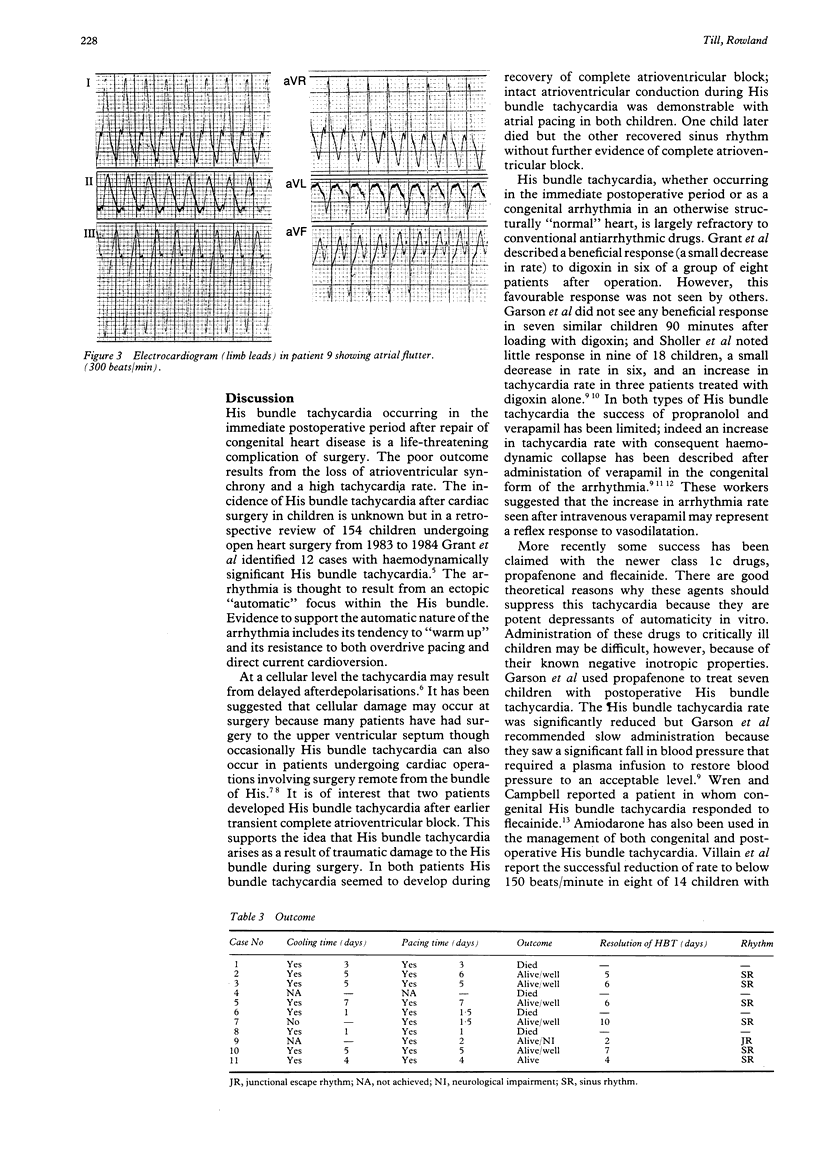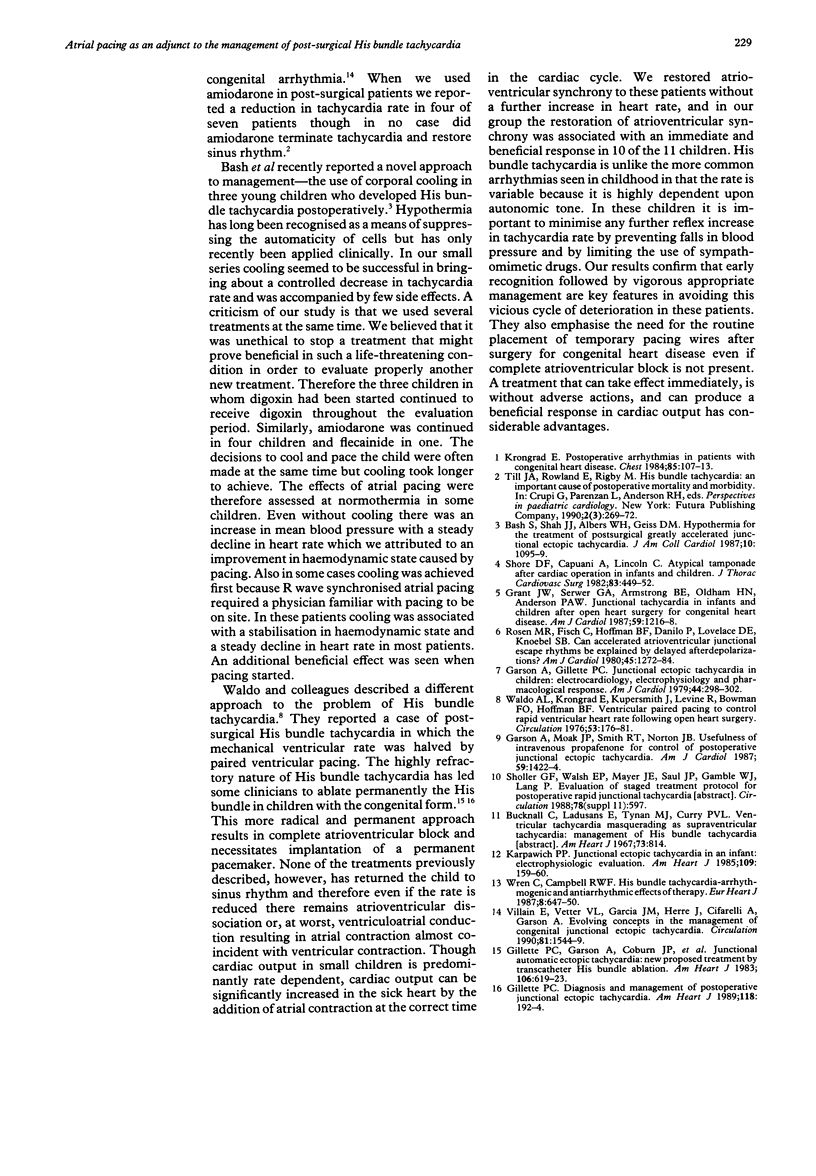Abstract
OBJECTIVE--To examine the benefits of restoring atrioventricular synchrony to children with His bundle tachycardia after operation for congenital heart disease. DESIGN--Review of clinical outcome of adopting the technique of R wave synchronised atrial pacing as an adjunct to the management of His bundle tachycardia from September of 1987 till June of 1990. PATIENTS--Eleven consecutive children (aged between 3 days and 13 years) with haemodynamically significant His bundle tachycardia after cardiopulmonary bypass surgery. INTERVENTIONS--Atrial pacing synchronised either manually or automatically to the R wave of the His bundle tachycardia was implemented so that atrial depolarisation preceded the following R wave by an appropriate PR interval. RESULTS--An immediate and sustained increase in mean systemic blood pressure (average 15 mm Hg, range 6-30 mm Hg) was seen with the onset of atrial pacing in 10 of the 11 children. One child, who had undergone a Fontan procedure, developed atrial flutter shortly after the onset of atrial pacing and required direct current cardioversion. Four children died. Of the seven survivors, six have sustained sinus rhythm which returned between two and 10 days after the onset of tachycardia. One of the survivors has severe neurological impairment attributed to a period of low cardiac output during tachycardia; the others are alive and well. In those children who did badly the mean time between arrhythmia occurrence and the start of atrial pacing or cooling or both was nine hours; in those who did well it was one hour. CONCLUSIONS--Atrial pacing synchronous with the His bundle is a useful adjunct in the management of children with His bundle tachycardia after surgery for congenital cardiac disease.
Full text
PDF




Selected References
These references are in PubMed. This may not be the complete list of references from this article.
- Bash S. E., Shah J. J., Albers W. H., Geiss D. M. Hypothermia for the treatment of postsurgical greatly accelerated junctional ectopic tachycardia. J Am Coll Cardiol. 1987 Nov;10(5):1095–1099. doi: 10.1016/s0735-1097(87)80351-0. [DOI] [PubMed] [Google Scholar]
- Garson A., Jr, Gillette P. C. Junctional ectopic tachycardia in children: electrocardiography, electrophysiology and pharmacologic response. Am J Cardiol. 1979 Aug;44(2):298–302. doi: 10.1016/0002-9149(79)90320-5. [DOI] [PubMed] [Google Scholar]
- Garson A., Jr, Moak J. P., Smith R. T., Jr, Norton J. B., Jr Usefulness of intravenous propafenone for control of postoperative junctional ectopic tachycardia. Am J Cardiol. 1987 Jun 1;59(15):1422–1424. doi: 10.1016/0002-9149(87)90935-0. [DOI] [PubMed] [Google Scholar]
- Gillette P. C. Diagnosis and management of postoperative junctional ectopic tachycardia. Am Heart J. 1989 Jul;118(1):192–194. doi: 10.1016/0002-8703(89)90098-7. [DOI] [PubMed] [Google Scholar]
- Gillette P. C., Garson A., Jr, Porter C. J., Ott D., McVey P., Zinner A., Blair H. Junctional automatic ectopic tachycardia: new proposed treatment by transcatheter His bundle ablation. Am Heart J. 1983 Oct;106(4 Pt 1):619–623. doi: 10.1016/0002-8703(83)90077-7. [DOI] [PubMed] [Google Scholar]
- Grant J. W., Serwer G. A., Armstrong B. E., Oldham H. N., Anderson P. A. Junctional tachycardia in infants and children after open heart surgery for congenital heart disease. Am J Cardiol. 1987 May 1;59(12):1216–1218. doi: 10.1016/0002-9149(87)90887-3. [DOI] [PubMed] [Google Scholar]
- Karpawich P. P. Junctional ectopic tachycardia in an infant: electrophysiologic evaluation. Am Heart J. 1985 Jan;109(1):159–160. doi: 10.1016/0002-8703(85)90429-6. [DOI] [PubMed] [Google Scholar]
- Krongrad E. Postoperative arrhythmias in patients with congenital heart disease. Chest. 1984 Jan;85(1):107–113. doi: 10.1378/chest.85.1.107. [DOI] [PubMed] [Google Scholar]
- Rosen M. R., Fisch C., Hoffman B. F., Danilo P., Jr, Lovelace D. E., Knoebel S. B. Can accelerated atrioventricular junctional escape rhythms be explained by delayed afterdepolarizations? Am J Cardiol. 1980 Jun;45(6):1272–1284. doi: 10.1016/0002-9149(80)90489-0. [DOI] [PubMed] [Google Scholar]
- Shore D. F., Capuani A., Lincoln C. Atypical tamponade after cardiac operation in infants and children. J Thorac Cardiovasc Surg. 1982 Mar;83(3):449–452. [PubMed] [Google Scholar]
- Surawicz B. Relationship between electrocardiogram and electrolytes. Am Heart J. 1967 Jun;73(6):814–834. doi: 10.1016/0002-8703(67)90233-5. [DOI] [PubMed] [Google Scholar]
- Villain E., Vetter V. L., Garcia J. M., Herre J., Cifarelli A., Garson A., Jr Evolving concepts in the management of congenital junctional ectopic tachycardia. A multicenter study. Circulation. 1990 May;81(5):1544–1549. doi: 10.1161/01.cir.81.5.1544. [DOI] [PubMed] [Google Scholar]
- Waldo A. L., Krongrad E., Kupersmith J., Levine O. R., Bowman F. O., Jr, Hoffman B. F. Ventricular paired pacing to control rapid ventricular heart rate following open heart surgery. Observations on ectopic automaticity. Report of a case in a four-month-old patient. Circulation. 1976 Jan;53(1):176–181. doi: 10.1161/01.cir.53.1.176. [DOI] [PubMed] [Google Scholar]
- Wren C., Campbell R. W. His bundle tachycardia--arrhythmogenic and antiarrhythmic effects of therapy. Eur Heart J. 1987 Jun;8(6):647–650. doi: 10.1093/oxfordjournals.eurheartj.a062336. [DOI] [PubMed] [Google Scholar]


